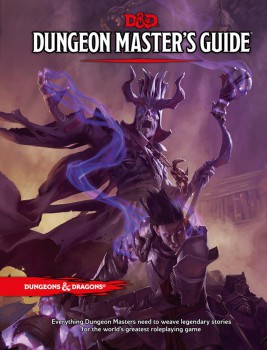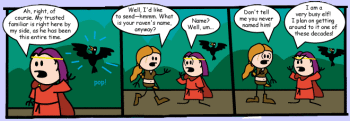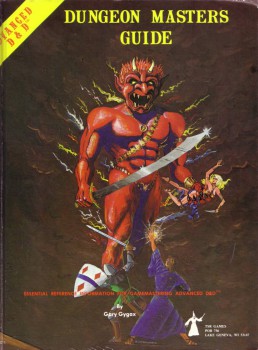Art of the Genre: Playing D&D 5E and an In-Depth Look at the new DMG

I’ve spoken a bit in the past about both the 5E Player’s Handbook, as well as the Monster Manual, but today I’d like to take a more in-depth look at the system and the new Dungeon Master’s Guide that will be released this week (the 9th) from Wizards of the Coast.
Unlike my fearless editor John O’Neill, I’m actually going to give you a look at the product beyond reading the jacked cover. [Sorry John, but I couldn’t resist.]
So, let’s get started. My initial impression of D&D 5E was that I wouldn’t be interested in learning a new system as I hadn’t even attempted to pick up D&D 4E. However, after reading the Player’s Handbook, I was intrigued, as were my gaming friends, who had recently returned to playing traditional Advanced Dungeons & Dragons in 2011 after a two year romance with Pathfinder.
Their interest, as well as a thorough read of the PHB, had me wanting to see how the system played on a table. Luckily, in early November, I got the chance to go back to my home town for a weekend in which an extended 5E session was planned.
Delving into the mechanics once more, I designed two characters, both from my Fleetwood family tree, and had the opportunity to lay hands on the system in a way a simple read won’t allow. Character creation, as any gamer knows, is paramount in getting your feet wet, and so once I had characters in hand I was even more excited to see how my abilities would interact with dice, once play began.
As per our usual dynamic, the DM duties were shared by both myself, running the social aspect of the campaign, and my old DM Mark, who ran the traditional dungeon delve side of a new campaign entitled ‘The Runelands of Daro’, set in my Nameless Realms.
Now, as stated in my initial review of the PHB, I believed that 5E took a great deal of its foundation from AD&D 1E, but as I rolled my first die in the system and witnessed my first combat, I quickly realized this wasn’t truly the case.
One thing OSR players take away from AD&D is the incredibly ‘basic’ design of the system. For all intents and purpose, AD&D ‘is what it is’, and because the game was ‘ended’ in 1989, after around a decade of Gary Gygax trying desperately to insure it stayed as static as possible, the system itself is both dry and yet thoroughly enjoyable in its age.
Nothing better represents this, shall I say ‘intractability,’ better than character advancement, which is both brutal and uninspiring. Simply put, a player [depending on the DM’s generosity and willingness to bend rules] can spend countless hours at 1st level, struggling again and again to survive with 8 hit points or a single spell, only to finally, FINALLY, make 2nd level and… wait for it… roll for hit points, perhaps add one new spell, and be ready to adventure again! Seriously, that’s it, and for most young players that is far too anti-climactic to enjoy. For us old folks, however, who grew up with this system and want everyone to get off our lawn, we somehow take it as a badge of honor that ‘in our day’ we didn’t complain about level advancement because we actually earned what we got.
Well, if that is what you enjoy, 5E probably isn’t for you, and the more I played the more I witness the very well developed evolution of D&D 3E in this product, or more honestly, Pathfinder.
This game is really the next step in that process, and Wizards of the Coast has done a stellar job of making a game that does correct the bloated dragon that is Pathfinder [although it has also opened the door itself for the same gluttony of supplementation that could very quickly ‘break’ the system they so valiantly developed here].

Now, considering how much I’ve played 3E, 3.5, and Pathfinder over the past decade, it is little wonder that I really LOVED how 5E played during that weekend. The game was smooth, the characters were impressively competent at 1st level and the spell-casters were actually valuable throughout the ENTIRE adventure, instead of just a single encounter. Personally, I think that change alone is enough to recommend the game to all players, but that’s just me.
That isn’t to say that after playing it a part of me will be more than happy to switch back and forth between classic AD&D and 5E, which I fully intend to do, but nonetheless, 5E is certainly here to stay in my gaming group.
But back on topic after that bit of digression, which is to say what the heck do I think of the DMG?
Well, to be honest, I’m not as impressed as I was with the PHB or the Monster Manual. Having come up through the edition wars, there is one thing that I take away from all products in the D&D line, and that is the fact that the original AD&D DMG is a masterful wellspring of gaming knowledge. No other supplement has ever come close to it, and no matter what edition I’ve played, that particular book is STILL used to settle certain disputes or answer questions that just can’t be found in other products.
I will also say that the 3E DMG too was an outstanding product and a great addition to the game, but once Paizo got the idea to bundle both the PHB and DMG into one massive tome with Pathfinder, the ‘need’ for a separate DMG seems to have waned for most RPGs.
Considering the fact that my gaming group played the entire weekend without a DMG speaks volumes to that fact that the 5E PHB in all reality, even in its slim size, functions on its own without true need for the DMG to back it up.

As I read through the book I was quickly aware of a dynamic shift in what the DMG was supposed to be in 2014 instead of 1980. Rather than being a system mechanic resource for the Dungeon Master, this book instead becomes a how to guide for actually becoming a Dungeon Master. To be clearer, the AD&D DMG by Gygax devotes exactly one, and let me repeat that, ONE, paragraph of text to the instruction of being a DM entitled ‘Approaches to Playing Advanced Dungeons & Dragons’. That’s it for what looks like 8 point type to these aging eyes in a 235 page book.
The 5E DMG devotes the first 127 pages to teaching a novice player how to by a Dungeon Master in this system. Where Gygax made the assumption that an aspiring DM needed to sit at a table as a player and learn the system from another, become inspired, and then extrapolate on what they’d learned firsthand, the folks a Wizards of the Coast have gone in the opposite direction and believe anyone buying this book has never really played D&D before and needs instruction on how to DM the game.
Who is correct? I’ve no real idea, or am biased toward Gygax’s view because of my age, but whatever the case the 5E DMG devotes half its pages to sections like ‘A World of your Own’, ‘Creating a Multiverse’, ‘Creating Adventures’, ‘Creating Nonplayer Characters’, ‘Adventure Environments’, and ‘Between Adventures’.
All these things are certainly well thought out and designed, and should you not have experience with the game are a very nice resource, but for an experienced player seem to be largely wasted text.
It takes until page 133 to discover the first real ‘crunchy’ resource, that being the treasure section. However, it is HUGE! The next hundred pages of the book are dedicated to treasure, including artifacts, with brilliant artwork depicting almost every piece in the game.
From there, the book drops back into teacher mode, taking the reader in a ‘Running the Game’ section that talks about table rules, dice, using ability scores, social interaction, etc, all of which were pretty well covered already in the PHB.
This is followed with the ‘Dungeon Master’s Workshop’ section containing ‘options’ that I firmly believe are a quick way for any DM, both young and old, to break what is already a very nice system. Concerning this, after running 5E, I would STRONGLY suggest NOT using the Feat option for your game. I promise you it will break the game much quicker than it will add to the fun.
And finally, there are two full pages dedicated to the creation of a dungeon, defining things like a starting area, passages, doors, chambers, stairs, and connecting areas… yep, I’m not joking. This is really a full-on beginner’s text.
So, my professional gamer opinion from reading of the 5E DMG says that it adds very little to the mechanical knowledge to the setting, but instead acts as a kind of Gazetteer for the Forgotten Realms, a Manual of the Planes, and finally a book of Wondrous Items.
At no time during my reading did I say ‘now that’s new‘, or ‘this is really important to my current game’. Instead, I was certainly entertained by the planes [which I personally love] and finally got a price point for the sale of that Ring of Fire Resistance the party found and didn’t really have a use for during ‘Runelands of Daro’, but otherwise I didn’t see a true ‘need’ for this book to play the game successfully.
Now, that isn’t a knock on the writing or content in their own right, all are well done, as is the artwork, but other than the needed brokerage of magical items for the DM and players, this book falls well short of a ‘must have’ to the collection and I certainly have a hard time calling it a ‘core’.
I think that some of this disappointment comes from the fact that as a DM I was so incredibly impressed with 5E monsters that I just knew, nay hoped, the DMG would expand on what the designers had done to make my ‘job’ as a DM even more fun.
You see, when playing, the new ‘advantage/disadvantage’ mechanic is pure genius, especially in the monster design. Having the ability as a DM to actually ‘make monsters think’, with an ease unmatched in any other D&D system, was more fun than I’d thought possible. Having actually had my players say, ‘Damn, I’d rather fight another Hill Giant than a gang of goblins’ was pure joy because the once ‘throw away’ goblin encounter took on such new life. And that isn’t to say 5E made goblins ‘tough,’ [they still have minimal hit points] it simply gave the DM the ability to actually USE goblins in a fashion that created a sense of lethality not seen before.
I wanted the DMG to be an extension of that, or at the very least some reflection of the content found in the classic AD&D DMG, and I walked away with neither. So the question then becomes, ‘do you need this book?’ Well, the short answer is yes, because you must set the market and mechanic for magical treasure. However, don’t expect much more than that unless you are playing D&D for the first time, want to set a campaign in the Dalelands of the Forgotten Realms, or are planning an adventure that travels through the various inner and outer planes.
Whatever the case, my dear readers, I’m currently inspired enough by both products to be running a gaming module Kickstarter that will allow you to play both 1E AD&D and 5E as you choose, so I hope you’ll take a look. Again, both systems are great fun, and I’ve had a blast putting together the OSR feel while getting to also play with new mechanics that can be used if you want to try 5E.
Interesting review. Someday I will need to teach my kids how to play RPG’s, and it might be a good thing to have a more modern guide for true beginners than the old DMG. How does 5E’s use of advantages and disadvantages differ from those same features in good old GURPS?
Sarah: I sent you a note on FB but haven’t heard back from you. Still, concerning the 5E mechanic, let me use the Goblin example. Goblins are weak, but they can be found with Worgs. Worgs aren’t super strong, but they have an attack which is a knock down. If you are knocked down,and are prone, ANYONE attacking you gains ‘advantage’ [which means you roll two attack rolls and take the higher result]. Therefore, if you are a thinking DM, you have the goblins wait for their Worgs to attack, see what characters get knocked down, then attack in gangs against the prone character. It is fantastic! 🙂 So, although I can’t attest to GURPS [never played it], advantage means two rolls higher result and disadvantage means two rolls lower result.
I’ve read a couple interviews with WotC representatives and it seems like they are really trying to prevent bloat with this particular edition. They are limiting their hardback releases to a much smaller number than 4th edition.
Which is good because, while i like 5th, i don’t see myself buying a lot of extra material. If i want to play in the Forgotten Realms I’ll open up my beloved 3.5 campaign setting.
Pathfinder put out a stripped down version that’s good for complete beginners (like kids).
http://paizo.com/pathfinderRPG/products/beginnerbox
Thank you, Scott. If there was any remaining question, your post convinced me to stick with 1e. And I do appreciate your staying off my lawn.
[…] Art of the Genre: Playing D&D 5E and an In-Depth Look at the New DMG […]